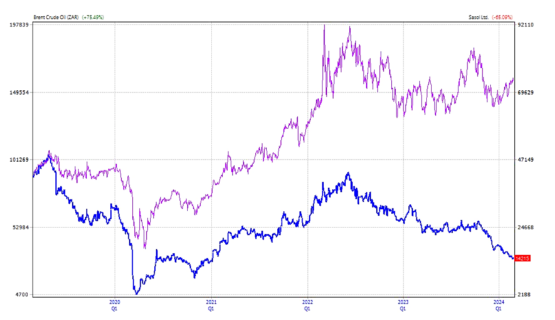It’s clear that Sasol is not for the faint-hearted. Its share traded on Monday at R142, down two thirds from the R436 peak reached in June 2022. It was back up above R143 by the close of trade on Monday.
The consensus view among analysts is that it is a buy at these prices, notwithstanding the potential for further downside.
The price-earnings (PE) ratio – both historic and forward – is below four, with a dividend yield above 11% before the release of the group’s half-year results to 31 December 2023 on Monday.
In most books, that’s a relatively attractive proposition – except the latest results are sombre.
Sasol announced a 200c dividend at the halfway stage, down from 700c for the prior six months to December 2022.
That’s a sizeable drop, paid out of retained earnings, and brings the annualised dividend yield to less than 3%.
The company needs cash to maintain its operations over the coming year, so shareholders will have to take it on the chin for now. The chart below shows a reasonably strong correlation between Sasol and crude oil prices (in rands), though that correlation has been ruptured over the past six months.
Sasol share price (blue) v Brent crude in rands (purple)
Source: ShareMagic™
The big damage to the earnings column came from mining and gas, and the chemicals businesses in Africa and the Americas. Group turnover was 9% lower at R136.3 billion (2022: R149.8 billion) mainly due to lower chemical prices.
Earnings before interest and tax (ebit) was R15.9 billion, 34% lower than the prior period, as reduced revenue and squeezed margins filtered through to the income statement. Part of the earnings drop was due to lower valuations of financial instruments and derivative contracts, though this was offset by reduced chemical feedstock prices in Europe, Asia and the US.
The results were further bashed by R5.8 billion in impairments at the Secunda liquid fuels refinery cash generating unit and the chemicals business – mainly due to lower selling prices in chemicals, the worsening macro environment for fuels, and higher electricity prices.
“This was a tough period operationally,” says Anchor Capital investment analyst Seleho Tsatsi.
“The mining business struggled with productivity. Poor free cash flow generation has led the board to reconsider its dividend policy which will be announced with June 2024 [full-year] results. Sasol expects to be free cash flow positive for the full-year, though the chemicals business is a big drag on earnings at the moment.”
As to whether Sasol is a buy at these prices, Tsatsi says some of the share price decline is cyclical and some due to structural issues.
Capital allocation uncertainty and questions over long-term climate change impacts are likely to be weighing on valuation, and environmental groups are targeting Sasol with laser beam intensity, as one might expect given its massive coal-to-gas operations and legendary carbon emissions.
The gas business struggled due to the higher cost of gas from Mozambique. “Taking more of a bird’s eye-view, commodity prices – notably chemical and energy prices – will be the major driver of earnings,” says Tsatsi.
“Feedback from Sasol today [Monday 26 February] was that chemical prices have stabilised but remain lacklustre in key markets. A buyer of the share would likely need to have a positive view on those markets.”
Natural gas pressures
Exness chief market analyst Terence Hove adds that Sasol’s monopoly as South Africa’s natural gas supplier has created a rather peculiar position for a country with no natural alternative supplies.
“Sasol advised that there is another imminent energy crisis – that of natural gas. It will terminate supplies from its fields in Mozambique mid-2026. The Pande Tomane fields are depleted with roughly 20-22 months of supply left.
“This reality has adversely impacted the outlook for Sasol, and that’s reflected in the share price, bearing in mind that it has enjoyed a [local] monopoly in this market for decades.”
Outlook
Earlier this year JP Morgan cut its target price for Sasol to R184 from R248, prompting a sharp drop in the share price.
In a note to investors it said it found it difficult to value Sasol due to uncertainties over long-term cash flows, while weaker chemicals prices forced it to reduce its earnings expectations. There’s also concerns that it will battle to pay its debts in the absence of a brisk recovery in chemicals prices.
In the latest Sens announcement, the board says it is satisfied that the company is liquid and solvent and has sufficient capital after paying a 200c dividend to maintain its operations for the current year.
Sasol earns about half its revenue in SA and has been trying for decades to reduce this concentration risk by breaking into foreign markets.
In 2023, some 55% of its investment was ploughed into the US (which last year accounted for 16% of revenue), 26% into SA, and the rest mainly in Mozambique and Europe.
Sasol is not alone in facing down withering demand in some of its key markets. Earlier this month, Shell reported a 29% drop in earnings to $28.25 billion (R546 billion) for 2023, though this was after reporting record profits in 2022.
Chevron reported earnings of $2.3 billion (R44 billion) for the fourth quarter of 2023, nearly a third that of the same quarter in 2022, citing lower upstream realisations, weaker margins and impairment charges as the key reasons.
At these low prices, Sasol is grabbing the attention of investors and analysts, many of whom were on board when prices were a good deal higher just a month or two ago.
At R143, this may be an overshoot to the downside, but the road to recovery is likely to be long and hard.
Listen to Jimmy Moyaha’s discussion about the interim results with Sasol CFO Hanré Rossouw in this SAfm Market Update with Moneyweb podcast:
You can also listen to this podcast on iono.fm here.
Results announcement

View or download a pdf of the above here.

